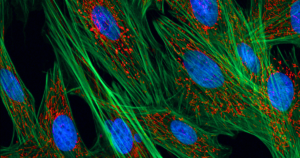Study: “Zombie” cells in the body produce “cryptic” molecules linked to aging
In movies and TV shows, zombies are reanimated corpses that can bite living people and turn them into zombies.
According to a study, “zombie cells” in the body that are linked to age-related diseases also produce “small, strange molecules not seen in normal cells.”

While the exact function of these “cryptic” molecules is still unknown, researchers report that they may have finally figured out why zombies build them.
Details of the study were published in the journal Natural Aging.
Senescent cells linked to inflammation that contributes to diseases
Zombie cells are scientifically known as “senescent” cells. They don’t die, but they stop dividing because of damage or stress.
These “undead” cells produce molecules that rally the immune system and trigger inflammation. However, senescent cells aren’t all bad as research suggests they also help repair damaged tissues.
But as your body ages, these zombie cells start to accumulate and trigger inflammation that is linked to age-related diseases like Alzheimer’s disease, cancer and osteoarthritis.
Senescent cells also undergo a process called “cryptic transcription” in which cells mistakenly use supershort snippets of DNA or fragments of genes to build tiny molecules of RNA, DNA’s molecular cousin. Normally, cells use RNA blueprints to build proteins.
Cells also usually read genes starting at specific locations on the DNA molecule. Like how a capital letter marks the start of a sentence and a period marks its end, genes have similar designated start and end points. But in cryptic transcription, cells may start reading in the middle of a DNA “sentence,” and the cell produces an unusually short RNA molecule.
Cryptic RNAs may “sap cell resources”
As of writing, the exact function of these cryptic RNAs is still unknown.
But according to Payel Sen, a molecular biologist at the National Institute on Aging within the National Institutes of Health (NIH), the production of these small molecules may sap the cell’s resources, making it grow less efficient with age.
Additionally, the cell may use the instructions within the RNA to build tiny proteins that can hinder the cell’s normal functions.
Understanding why zombie cells undergo cryptic transcription and how this affects aging could help researchers learn more about the aging process. The knowledge could also be used to prolong life span and prevent age-related disease.
For the study, Sen and her colleagues took a closer look at the reason behind this phenomenon. The researchers found over 350 “cryptic sites” in human senescent cells by identifying gene fragments from which the unusual RNAs are made.
They also identified epigenetic changes at these sites that weren’t observed in young, healthy cells. These changes may explain why cryptic transcription happens. Epigenetics involves the study of molecules that latch onto DNA and affect which genes can be used to make proteins.
The research team reported that the epigenetic changes observed in zombie cells were specifically seen in histones, the spool-like proteins in chromosomes around which DNA is wound. The researchers also noted that the changes seemed to be linked to the age of cells.
In zombie cells, these epigenetic changes exposed parts of the genome to the cells’ RNA-making machinery, while in young cells, the same gene fragments were “hidden” and unexpressed.
These findings suggest that zombie cells undergo cryptic transcription because their ability to control gene expression declines over time and epigenetic changes accumulate on top of their DNA, influencing DNA transcription.
yogaesoteric
June 18, 2023
